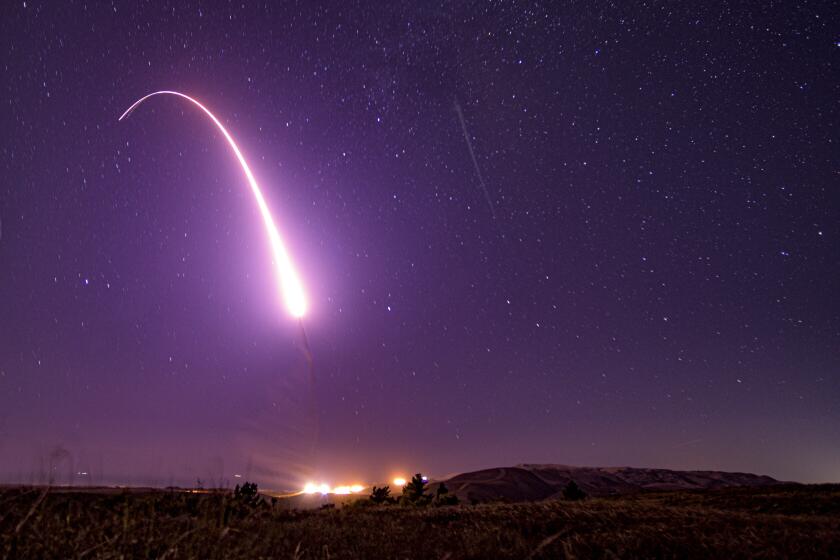Tunnel Revision : Quake-Damaged Aqueduct’s Overhaul Nears Completion
- Share via
NEWHALL PASS — Hundreds of feet underground, scores of workers turn the inside of a large Metropolitan Water District tunnel into a construction site each day, laboring to replace a steel liner that the Northridge quake bent into rippling waves.
Days after the January, 1994, quake crumpled the connector ramp between the Golden State and Antelope Valley freeways, MWD officials inspected the 20-foot-diameter Newhall Tunnel--which carries water from Castaic Lake to the Joseph Jensen Filtration Plant in Granada Hills--and discovered that their pipeline had been damaged along with the freeway that runs above it.
The concrete shell of the 3 1/2-mile tunnel was sound, said Rob Hallwachs, an MWD spokesman. But 160 feet of the half-inch-thick steel liner that keeps out oil and other contaminants was in some sections yanked several feet off the tunnel sides and crinkled like corduroy.
“No matter how hard we work or we over-design, the forces of nature can always do in the best engineering,” said engineer and project manager Leslie J. Barrett.
Despite temporary repairs after the quake, the tunnel still leaked 20,000 gallons a day, he said.
The district waited until February, when demand for water is lowest, to begin the $8-million reconstruction project that would replace the bent steel liner, add an additional 12-inch layer of concrete inside the steel liner and improve the tunnel’s drainage system, which prevents natural oil deposits from contaminating the water. The tunnel is as much as 220 feet below ground in places.
Hallwachs said the project is expected to be completed by the end of March. The MWD will apply to federal authorities for quake damage aid they hope will cover at least some of the expense.
Workers began by building a steel bulkhead to redirect water through Los Angeles Department of Water and Power pipelines, then lowered supplies down a 170-foot shaft in the hills alongside the Antelope Valley freeway, Barrett said.
They then installed an elevator, railroad tracks and pipelines for water and electricity, and then began erecting the scaffolding and a massive metal tunnel within the tunnel that would serve as a mold around which replacement concrete would harden.
When in service, the Newhall Tunnel brings water to Las Virgenes and Calleguas municipal water districts as well as to much of Los Angeles, including most of the San Fernando Valley. Built in 1971, it serves roughly 1.3 million families each year and annually carries about 200 billion gallons of water--or enough to fill 10 million swimming pools.
But on Tuesday, the 3,000-foot tunnel was dry, as it had been since the first week of February, except for a brackish pool of ground water that collected along the tunnel floor from a series of dripping leaks.
Inside, MWD employees work amid a cacophony of sounds that, combined with the string of covered lights hung on the sloping sides, give the tunnel an other-worldly quality.
Steady bangs, like gunshots, ring through the tunnel as concrete is intermittently discharged through a thin pipe along the tunnel floor; a deafening, vibrating whir resonates from the metal mold that shakes the concrete as it sets, and a loud hum and accompanying steady breeze whoosh through the tunnel as a giant fan in Newhall three miles away drags fresh air down the shaft and sucks it through the giant water pipe.
Workers, who have trouble hearing even shouts above the din, wear earplugs.
Tom Hand and other construction veterans deftly make their way through the tunnel on a foot-wide boardwalk down the center of the railroad tracks. Flatcars carrying equipment occasionally rumble by, sending the workers scurrying up the sloped tunnel sides, but not impeding their progress through the vast tube.
Lunch and water breaks are often taken on the tunnel sides as well, with workers perching on the pipes that run along the walls.
Although Hand and others said they missed the fresh air and sunlight of regular Southern California construction work at first, they have come to accept the conditions as just part of the job, Hand said.
“The first day, it makes you a little nervous,” Hand said. “You get used to it. It makes you appreciate the outside--it’s bright and clear.”
More to Read
Sign up for Essential California
The most important California stories and recommendations in your inbox every morning.
You may occasionally receive promotional content from the Los Angeles Times.










